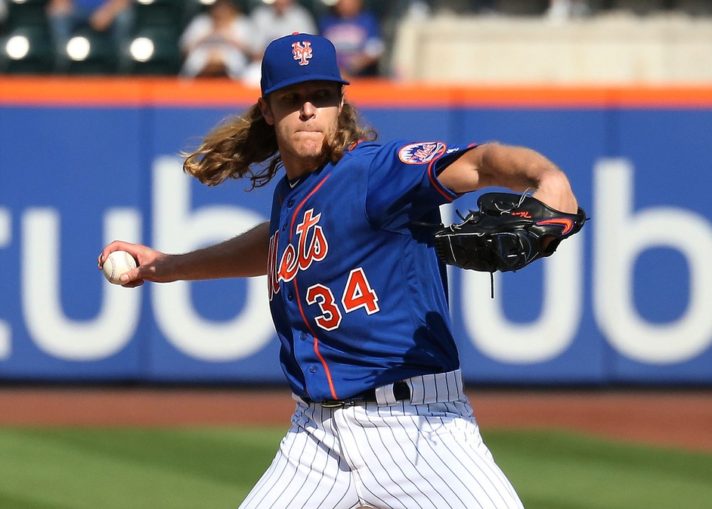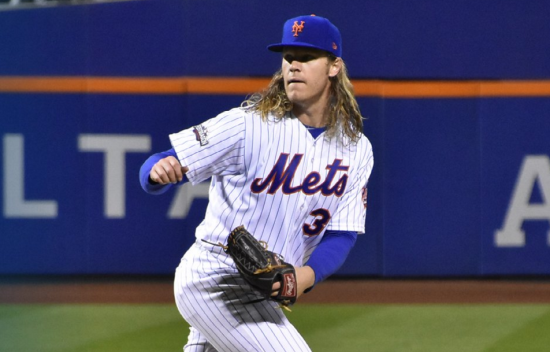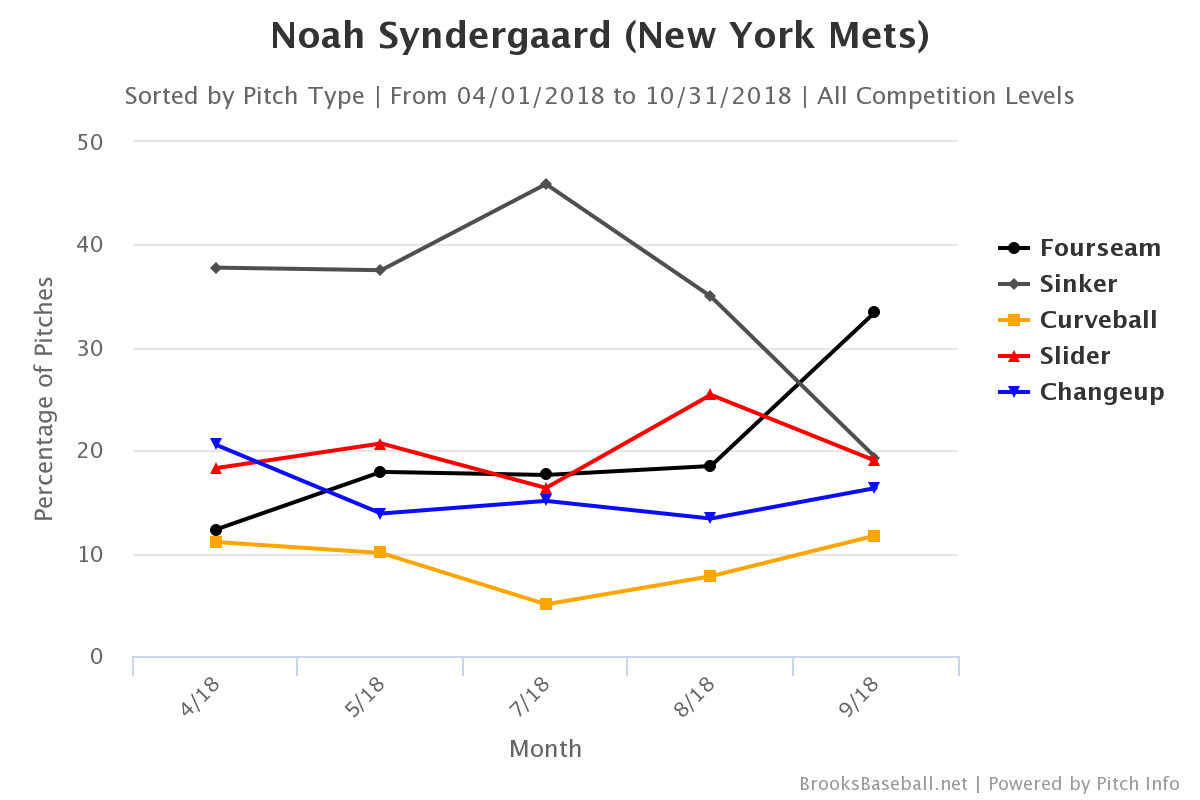
The Mets are blessed when it comes to power pitchers. In their stable, they currently house three starting pitchers who all top out over 95mph with their fastballs—Jacob deGrom, Zack Wheeler, and Noah Syndergaard. Degrom is coming off a Cy Young and one of the greatest pitching performances ever by a Mets pitcher in 2018, but Syndergaard may be the most intriguing of the bunch.
Prior to 2018, if asked out of the three pitchers listed above, to pick the pitcher you thought would be the first to win a Cy Young Award, I bet the overwhelming response would have been Syndergaard. Most would have agreed, as he was named the opening day starter in both 2017 and 2018. His stuff is electric, and his fastball is overpowering. But I don’t think anyone was overly shocked that deGrom took home the award first.
There is no doubt that Syndergaard has the stuff to win a Cy Young Award if he stays healthy, and I think it may happen sooner than later—as soon as 2019 even.
As the 2018 season progressed, there were some things that Syndergaard did differently that could signal that he is ready to leapfrog deGrom as the Mets dominant pitcher again.
I wrote last week that deGrom’s increase in frequency and execution of his slider was one of the main reasons why he transformed from good to great in 2018. DeGrom uses his four-seam fastball as his primary pitch and his slider as his secondary pitch. Watching deGrom’s success may have influenced Syndergaard as he also went through a little bit of a transition in 2018. Maybe he picked up on what deGrom was doing to make himself successful.
Towards the end of the 2016 season, Syndergaard’s primary pitch became his sinker, using it over 30 percent of the time. It replaced the four-seam fastball as his primary pitch, which he used over 35 percent of the time in the seasons prior to 2016. The spin rate on Syndergaard’s sinker (2152rpm, ranked 51 amongst pitchers that threw over 2000 pitches in 2018) make the pitch incredibly deceptive and hard for hitters to barrel up—however, this could also lead to less control over the pitch because it moves more.
Velocity plus a reduced spin rate causes the pitch to drop in the zone, thus more ground balls are hit or increased swings and misses. If you’ve ever seen Syndergaard throw this pitch, it’s as filthy as Pig Pen from the Peanuts cartoons, which could be why he fell in love with it.
When looking at all the starting pitchers in the MLB that throw over 95mph, Syndergaard was one of the only pitchers to use his sinker as the primary pitch in 2018—the majority use the four-seam fastball as their primary pitch, and sprinkle in the sinker almost like it’s an off-speed pitch (deGrom utilizes the sinker like this).

Rewind to 2016 when Syndergaard was an All-Star. He got off to a tremendous start that season, and he put up a career low in ERA (2.60), a career high in strikeouts (218), and ended the season ranked in the top 15 in the MLB for WHIP (1.15). But here’s the kicker—in August 2016, Syndergaard changed gears and started to utilize his sinker more often.
By September of that year, it was his primary pitch moving forward. He also used it more often in June 2016—the three months where he primarily used his sinker were easily his worst three months of that season. In the months he used his four-seamer as his primary pitch, he pitched to the tune of 2.40 ERA—the months he used the sinker, his ERA was 3.12.
If Syndergaard was a doing so well with his four-seamer as his primary pitch, why would he go against the grain (compared to most of the other power pitchers), and start using his sinker as his primary pitch? I can’t really answer that, but I’m sure he had a very good reason as to why he went that route.
As stated above, in September 2016, Syndergaard’s primary pitch was his sinker from that point on. He utilized his sinker anywhere from 35-45 percent of the time, and his four-seamer was utilized around 15 percent of the time on average. Syndergaard missed most of 2017, but in 2018, the sinker was still his primary pitch and he posted his second-highest ERA (3.03), highest WHIP (1.21), lowest K% (24.1%) and highest BB% (6.1%).
One could make a strong argument that 2018 was his worst season. Don’t confuse what I’m saying—I’m not trying to say that Syndergaard had a bad year in 2018, I’m simply saying that maybe something was off—and by seeing what Syndergaard did towards the middle of August last year, maybe he felt the same way.
By September, Syndergaard started utilizing his four-seam as his primary pitch again. This looked to be a smart move on his part, as September proved to be his best month of the 2018 season (one of the best months of his career). He pitched to a 1.73 ERA, and hitters posted a slash line of .195/.264/.304—a powerful example of what he is capable of and a great building block headed into the 2019 campaign.
Prior to September, Syndergaard was starting his hitters off with a sinker 45 percent of the time—this dropped all the way down to 19 percent in September as his four-seamer became the pitch of choice in this situation. In addition, we saw an uptick in usage of his slider and changeup in two-strike situations—relying less on trying to blow a fastball by a hitter in those situations.
Let’s take this a step further. If we combine the months in 2016, the last time Syndergaard utilized his four-seamer as his primary pitch, with September 2018 (when he switched back to using it as his primary pitch), then project what a full season would look if he used his four-seamer as his primary pitch, this is what we get: Innings Pitched 208.5, ERA 2.16, 223K, 58BB.
I know that they take more into consideration when deciding a Cy Young Award, but with that stat line, Syndergaard would start to get his name into the discussion.
Maybe Syndergaard watched what deGrom was doing during his starts last season and began to apply a similar philosophy to his starts towards the end of the year. They say imitation is the best form of flattery (or something like that). Maybe Syndergaard looked at what made him an All-Star selection in 2016 and decided to replicate that. Whatever it was, Syndergaard decided to start using his four-seamer as his primary pitch and it helped him close out 2018 with an exclamation mark. If he can replicate what he did in September 2018 over the span of the 2019 season (and remain healthy), the Mets may have to make more room on the mantle for another Cy Young award.















